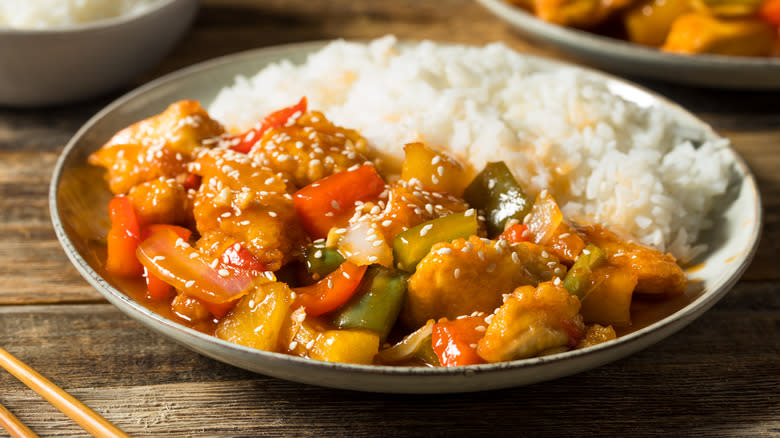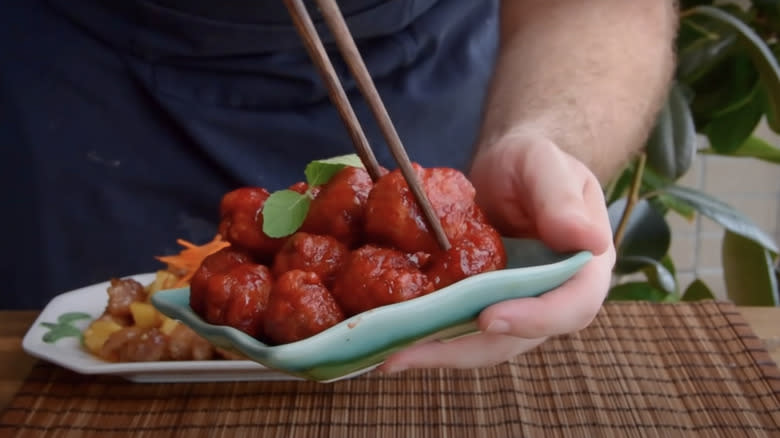The Multicultural Origins Of Sweet And Sour Chicken

For most of us, no Chinese restaurant order is complete without a serving of sweet and sour chicken. The typical platter of sweet and sour chicken consists of vibrant colored, syrupy sauce drizzled over fried, crispy nuggets of chicken, and is usually accompanied by a fruit and vegetable medley of onions, peppers, and pineapple, and a sprinkling of sesame seeds. It's got a touch more zest and acid to it than, say, sesame chicken, another American Chinese go-to -- but it's less cloyingly sweet than orange chicken, which has a sauce literally made of orange juice. Although these flavors and ingredients for sweet and sour chicken feel ubiquitous, they're actually just one variation on the sauce.
Cantonese-style Chinese cuisine has had the greatest influence on American Chinese food, largely due to an influx of immigrants from the region and the generally mild nature of the food that folks of all spice tolerances can enjoy. That's why the Americanized version of sweet and sour very closely resembles authentic Cantonese-style sweet and sour chicken. But just like the U.S., China is a large and diverse country, with each region containing its own unique culinary traditions. And sweet and sour sauce is not just a Cantonese creation -- there are phenomenal sweet and sour sauces in many regions. And though pork is the go-to protein in China, chicken pairs beautifully with them all.
Read more: 16 Little-Known Facts About Salt
Regional Chinese Sweet And Sour Sauces

Sichuan vs. Cantonese cuisine exists across a spectrum. If Cantonese is on one end, Sichuan is on the other. The Sichuan Province, located in Southwestern China, is known for its aromatic, flavorful, and spicy food, and is also the (hotly debated) birthplace of kung pao chicken. Sichuan cooks use a heavy hand when it comes to garlic and chili peppers, and sweet and sour sauce is no exception, which includes chiles in some form or another -- whether that's whole and fresh, dried, or ground up in a paste or sauce.
Fujian neighbors Guangdong, so it has similar flavor profiles for sweet and sour, but this area is well known for its rice vinegars. Fuijan sweet and sour sauce incldues locally made, light rice vinegar for its sour component, but you'll also notice that it is a bright, crimson red. That's because the byproduct of vinegar making, dead yeast particles known as lees, take on this hue, which is then added as a natural food coloring. It's then traditionally added onto rolled balls of fried pork in a dish called "lychee pork," because the meat looks so similar to lychee fruits.
In the Northern Chinese province of Beijing, the local sweet and sour is usually paired with beef, which has historically been more popular in this region. This sweet and sour is a bit like American barbecue sauce, using ingredients that individually contain sweet and sour elements like ketchup, tomato paste, and hoisin.
Sweet And Sour Beyond China

If you think there's a lot of sweet and sour sauce variation in Chinese cuisine, it shouldn't surprise you to know there's just as much variety throughout most of Asia. Thailand, Korea, Japan, Vietnam, and the Philippines all have their takes on this delectable sauce, and of course, have even more variation between regions. In Japan, sweet and sour goes by amazu sauce. It's made simply of rice vinegar, sugar, and salt, and sometimes a bit of dried seaweed flakes for a briny, umami flavor. Amazu is used as a dressing, often drizzled over authentic sunomono -- a Japanese cucumber salad -- or on top of pan-fried chicken.
In the Philippines, you'll find a less pungent sweet and sour sauce, which consists of vinegar, water, sugar, salt, oyster sauce, and ketchup, and is thickened by a cornstarch slurry. This offers a more delicate balance of the acidic and sugary notes than some sweet and sour recipes. It's usually used as a sawsawan or dipping sauce, which goes beautifully with anything from plain rice to chicken wings.
One international sweet and sour sauce that you've almost undoubtedly tried in America comes from Thailand. It's often served on top of chicken skewers, or just in a tabletop bottle to drizzle on anything and everything. It's made up of the wonderfully sweet pineapple juice, like Cantonese-style sweet and sour, but what really makes it stand out is the use of piquant cayenne and/or red pepper flakes.
Read the original article on Mashed

